Sometimes as we photograph birds, things happen quickly, in concert, out of concert, and sometimes concurrently. That’s pretty much the way things transpired as my brother Jim and I stood, cameras in hand, before a pair of American Oystercatchers that I spent a considerable amount of time photographing. Jim had just joined me after already hiking the entire lagoon that stretched north, sharing that there were several Piping Plovers half a mile up the lagoon – another species I hoped to photograph that morning on the barrier island on the Gulf side of Tampa Bay.
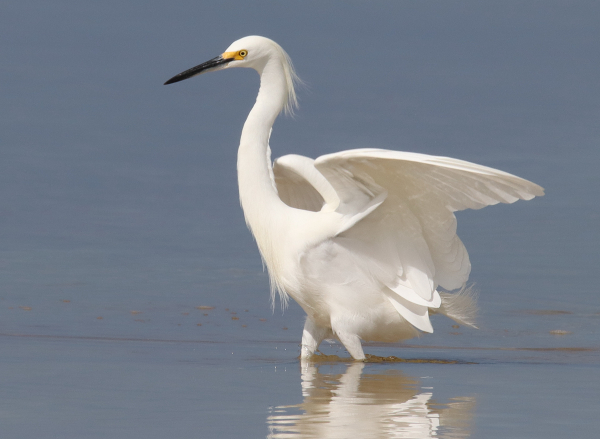
As we talked a moment, a Snowy Egret was working its way ever-closer while becoming ever-more active in its search for small fish in the tranquil shallows – catching our attention, pressing both our cameras quickly into action. The lighting was beautiful, a bit subdued with the glassy blue-gray color of the water providing a perfect setting that emphasized the white egret in action. Even the shadows were subdued, which enhanced the beauty of the bird as it danced and ran and spinned, then lifted up on white wings to drag its yellow toes along the surface of the water to chase small fish before it.
This was definitely the most action I’ve seen among the many, many Snowy Egrets I’ve observed over the years, so it was creating a memorable photo op, with an equally rare chance to share a photo session with Jim. It all happened pretty quickly, and between the two of us the sound of our dueling camera shutters was testament to the attraction of this egret’s unexpected behavior. The action was reminiscent of a Reddish Egret, but frankly, the Snowy showed more elegance and agility, thereby providing primo photos.
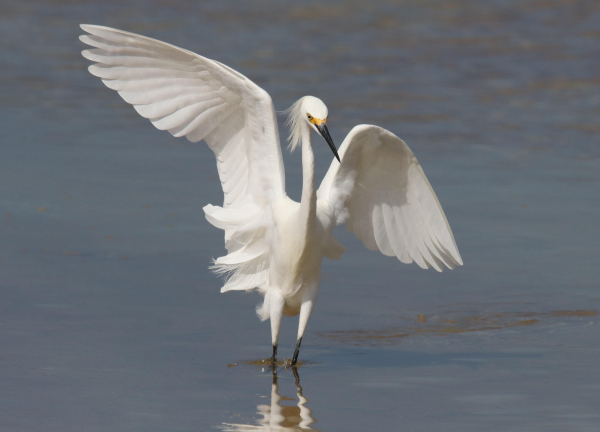
Tech Insights
As noted above, photographing the quick action provided by the Snowy Egret was fast-paced and unexpected, so it wasn’t possible to make any changes to my camera’s settings. However, I was already dialed in for the exact lighting and water-based surroundings while photographing the pair of American Oystercatchers, so there really was no call for changes to those “perfect” settings under the perfect photo conditions that Wednesday morning.
Using the Av (aperture priority) setting on the top of my Canon camera’s Mode Dial, I had the aperture (f-stop) set at f-10, which provided a fairly broad area in focus before and behind the focal point – the egret. With the Av setting, the camera automatically provided the associated shutter speed, which is determined by the amount of available light detected in your photo frame. I had already been photographing the oystercatchers in almost the same location, so I was monitoring the shutter speed, which was being provided at the very fast rate of 1/2500th of a second to 1/1600 – fast enough to stop the action of the egret’s motions. As the baseline, I had my ISO set at 400, my usual setting when photographing in full sunlight conditions.
Using my Tamron 150-to-600mm zoom lens, I zoomed it back to a 500mm magnification to be sure that I could fit the egret’s spread wings and long legs into each frame without worrying about clipping a part of a wing as the egret moved quickly, if not recklessly in its animated flurry. Using the 500mm zoom setting I could easily keep the bird in the photo frame, and could always crop extraneous surroundings during post-production editing.
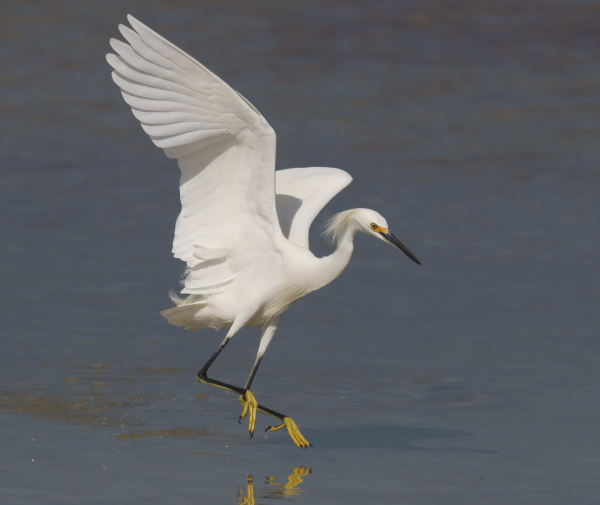
As usual, I had my camera’s Al-Servo (Drive Mode) set at “continuous,” so I could take a rapid-fire series of photos at a rate of up to 7 per second (tops with my camera model). Using this setting, I can take a single photo, but can also take 2 or 3 at a time if you hold the shutter button down a moment longer. And when a bird is especially active, as in the case of this Snowy Egret, I held the shutter release button down for the camera to take a continuous series of images when the bird took momentary flights. I tried to anticipate its next move, or movements, a split-second endeavor. What fun to have such an animated, graceful, beautiful bird actively creating its own ballet before us.
Of course, I held my breath while pressing the shutter button and held the camera and lens as steady as possible while following the egret’s enthusiastic activity. I was already in position with the sun behind me and the egret in front of me, and my shadow pointing toward the Snowy for the best possible lighting. I was also trying to be aware of the shadows on the bird, but the action was so quick that it was impossible to make any adjustments that would help to avoid taking photos with harsh shadows. But I was very lucky in the shadow department; the shadows were not very obvious, and what few shadows appeared in the photos were not harsh or dark but effectively subdued – what luck.
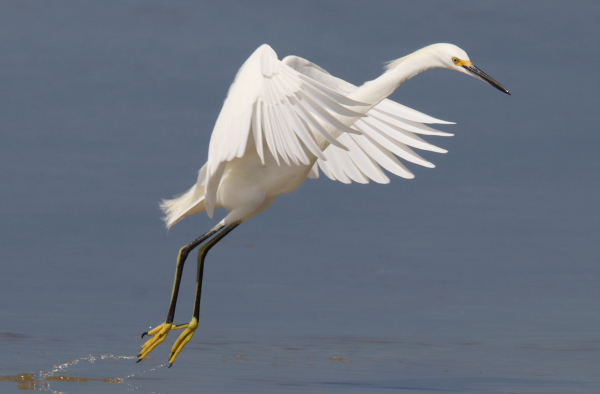
Bonus Photos
As noted in the beginning of this article, I was actually immersed in photographing the pair of American Oystercatchers when Jim arrived, and later Piping Plovers and sandpipers attracted my attention next. Usually a Snowy Egret might afford a photo or 2, then I’d move on. But when this Snowy became active, clearly within the range of our zoom lenses, 2 photos turned into many as the action evolved before us. The photos that illustrate this feature were actually taken within a minute of time, which underlines the importance of being alert, reacting to the birds around you – even if they aren’t your current photo subject – and follow the action with anticipation for the next move, even while reacting to the current movements.
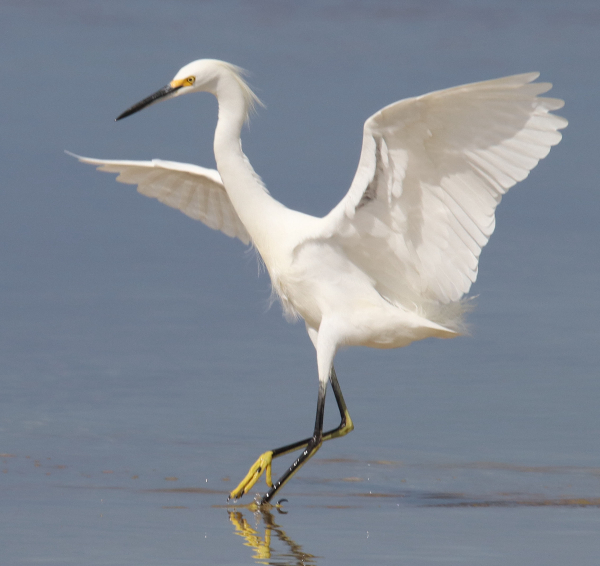
This image may show the most dance-like position and emphasizes how the water color sets off the egret’s plumage, including the subtle shadowing on the underside of its wings (500mm zoom, f-10 aperture, 1/1600 shutter speed, ISO 400).
|
This morning of bird photography stands out for the variety of birds encountered, and the quality of photos I was able to create. This is the third consecutive Bird Photography feature that I’ve shared that is based on the photos I took within a couple hours that first morning of February, which included the pair of American Oystercatchers in the February 8 issue, the Piping Plovers in the February 15 issue (last week), and the Snowy Egret in this article. They are all a testament to the variety of birds observed, the trust of those birds, the quality of images I was able to take, and the timing and luck involved in almost any photo session.
Timing had a lot to do with the weather, and the behavior of the many birds, emphasized by the fact that no birds were present when I returned to the same location 3 days later and found only a foursome of Snowy Plovers. In spite of the bright morning sun, the strong wind and cool temperatures following a low front that brought rain to the area the previous morning seemed to have changed the attraction to the area by the varied species of birds present during my first visit to Fort De Soto State Park on Mullet Key.
It certainly made those February 1st birds and photo opportunities a precious opportunity, and I’m glad to share 3 special articles that resulted from that eventful bird photography day – maybe my best among the many days of photographing birds in Florida that began in the mid-90s. That’s both exciting and rewarding, and it emphasizes the importance of getting out there, visiting bird-rich locations, and making the most of the bird photo ops we are afforded. Good Luck!
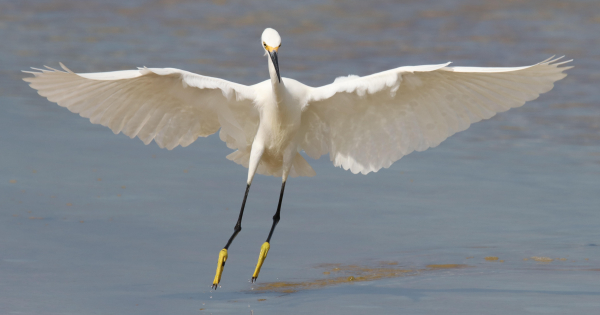
Article and photographs by Paul Konrad
Share your bird photos and birding experiences at editorstbw2@gmail.com